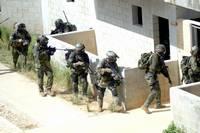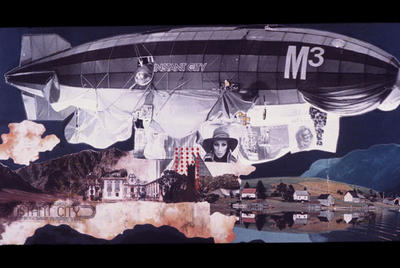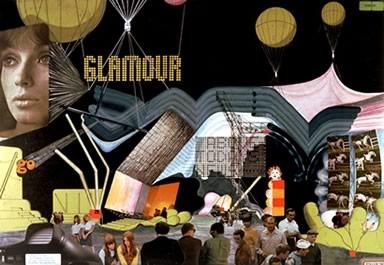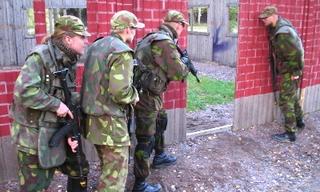A miniature city waiting for attack
"Tucked away in the hills north of San Luis Obispo is a miniature city waiting for attack. Concrete buildings with courtyards hug the grassy slopes, yards away from a 40-foot sniper tower and shooting ranges. They're part of the newly renovated urban assault training complex at Camp San Luis Obispo, which prepares California National Guard members for fighting in close quarters overseas."
This specific "urban assault training complex" is not at all unique, however, as an earlier post on BLDGBLOG has already explored. What's interesting is the way that these particular buildings are *designed* and *cinematized*: "Three small buildings at the complex are modeled after traditional Middle Eastern homes, complete with walled courtyards" – architectural ornament as target criteria. Adolf Loos would be proud. Within this artificial Marrakech, or Baghdad 2.0 – or a kind of Mini Me, Tehran-style – "[s]oldiers practice storming the buildings and shooting short-range plastic bullets at mechanized decoys as their commanding officers record the attack with video cameras."

(This is a photo of "a mock interview" – or media as extension of the architectural war environment. [And is that a man or a woman holding the camera...?]).
J.G. Ballard, from *The Atrocity Exhibition*: "war can be seen as a limited military confrontation with strong audience participation via TV and news media, satisfying low-threshold fantasies of violence and aggression."
Heavily-armed urban film production units temporarily inhabiting simulated cities: it's all in a day's work if you're discussing what's known as MOUT.

"Urban areas are expected to be the future battlefield," according to globalsecurity.org, "and combat in urban areas cannot be avoided. The acronym MOUT (Military Operations on Urbanized Terrain) is defined as all military actions that are planned and conducted on a terrain complex where man-made construction affects the tactical options available to the commander." These are "the advantages and disadvantages urbanization offers".
War, urban design, and "terrain complexes": it's armed men running through abstract environments.

MOUT, indeed, is "the future of warfare," according to the United States Army War College. The battlefield of future hostilities, as stated by the War College's own journal, "'lies in the streets, sewers, high-rise buildings, and sprawl of houses that form the broken cities of the world.'" Broken cities: Philadelphia, Los Angeles, Fallujah, Slough.
In fact, Mike Davis writes, MOUT – or the military's pursuit of urban design by other means – is indispensable to "Washington's ability to dominate what Pentagon planners consider the 'key battlespace of the future' – the Third World city." Rather than learn lessons of pedestrianization, or how to control sprawl, or even what radically mixed-use zoning really looks like, or perhaps the dire need for stricter environmental safety regulations, the "Third World city" apparently offers only one true lesson: how to attack.

This is "the Pentagon as global slumlord".
The First World military, Davis continues, is "unprepared for protracted combat in the near impassable, maze-like streets of the poverty-stricken cities of the Third World. As a result, the four armed services, coordinated by the Joint Staff Urban Working Group, launched crash programs to master street-fighting under realistic third-world conditions."
Producing so-called "realistic third-world conditions," of course, requires constructing decoy villages on rural U.S. military bases, as well as urban assault training complexes – complete with Middle Eastern ornaments – in the hills outside San Luis Obispo. Call it the new International Style, or perhaps Military Arabesque.
Or just call it "miniature cities waiting for attack."

(Sorry that image is so small – I'm not trying to be over-literal).
As the *Stars & Stripes* itself declares, the world's largest military is now running "various scenarios in 'Combat Town' as part of a Training in an Urban Environment (TRUE) exercise". The terminology here astounds: "various scenarios in 'Combat Town'" could surely be the title of a new short story collection by Don DeLillo, even as "Training in an Urban Environment (TRUE)" could be an effective new moniker for a Nike fitness campaign – yet they're both part of the US military's rhetorical framing of our combat-prone, global future.
Cities, as they exist in First World military simulations, are virtualized yet further through inclusion in Department of Defense video games. See, for instance, *Urban Resolve*: "Developed by the U.S. Joint Forces Command, or JFCom, a division of the Department of Defense, the $195,000 program is a combat simulation on a massive scale. (...) In other words, it's one part *Risk*, one part *The Sims* and one part raw supercomputing power. It's also the tool that could one day give the U.S. military the upper hand in urban conflicts akin to the ones currently taking place in Iraq."
"[U]sing concepts borrowed from artificial intelligence research," *Urban Resolve* functions somewhere between high-tech city planning assistant and future warfare prediction device, "helping military leaders determine which types of sensors – CIA agents, spy planes, listening devices and so on – are best for tracking enemy forces that are hiding in a modern city." Or, surveilling those city-dwellers virtually and in advance, using AI – so that you can cut off their power and kill them.
Such computer simulations are increasingly the norm "in a growing number of defense exercises. With ever-more-sophisticated simulation and modeling technology, the military today can mix and match real tanks, planes and ships with forces that exist only on computers – and those located in virtual training environments, such as pilots in flight simulators thousands of miles away." The First World military meets the entertainment industry – the so-called "military-entertainment complex" – via urban design and building contractors. But the phrase, "virtual training environments," as we've seen, can also be applied to modular, fake-Arabesque war villages built in the hills of California.
The Disneyfication of urban conflict; the Epcot Center of war.
This connection between architectural contracting and overseas military conflict can be glimpsed elsewhere. Return, for instance, to *Stars & Stripes*, where we read that, "[w]ith the ability to construct buildings and excavate land, the 94th Engineer Battalion seemed like the ideal choice for the mission at hand" – which, specifically, was base construction in Iraq. But this Battalion is the "ideal choice" for an overseas combat zone because it can "construct buildings and excavate land." Architectural contracting, or: urban war by other means.
See also the Virginia-based company, Anteon, a strange cross between Archigram and Dick Cheney. Anteon designs and manufactures modular training environments for law enforcement and military exercises, including "a mobile, reconfigurable MOUT training facility. Mobile MOUT is a comprehensive solution, providing a facility that would give units a modular, transportable training system, featuring:
• Fast set-up and disassembly...
• Various building sites configurations...
[and]
• Changeable interior room configurations"
– thus my comparison to Archigram.
Modular urban design: instant cities in the Third World desert, underwritten by the Pentagon.
A series of questions arises: is modular architecture's future not to be found within overproduced, avant-garde grad student projects, but in the now ubiquitous Third World battlefields that seem destined to grow in size and number? Is Third World urbanization a military (or refugee) phenomenon? If so, does global geopolitical conflict produce bull markets in modular architecture?
And is the U.S. Department of Defense actually leading the way when it comes to fulfilling predictions made so long ago by Archigram: that the cities of the future will be instant; they will be air-lifted in to the middle of nowhere; they will thrive in a state of continually incomplete assemblage; etc.?



Is the urbanism of the future *military urbanism*?

More images of simulated war-cities and their armed inhabitants from the virtualized future-present can be found here.
(This post briefly updated, 25 August, and later posted to nettime).
This specific "urban assault training complex" is not at all unique, however, as an earlier post on BLDGBLOG has already explored. What's interesting is the way that these particular buildings are *designed* and *cinematized*: "Three small buildings at the complex are modeled after traditional Middle Eastern homes, complete with walled courtyards" – architectural ornament as target criteria. Adolf Loos would be proud. Within this artificial Marrakech, or Baghdad 2.0 – or a kind of Mini Me, Tehran-style – "[s]oldiers practice storming the buildings and shooting short-range plastic bullets at mechanized decoys as their commanding officers record the attack with video cameras."

(This is a photo of "a mock interview" – or media as extension of the architectural war environment. [And is that a man or a woman holding the camera...?]).
J.G. Ballard, from *The Atrocity Exhibition*: "war can be seen as a limited military confrontation with strong audience participation via TV and news media, satisfying low-threshold fantasies of violence and aggression."
Heavily-armed urban film production units temporarily inhabiting simulated cities: it's all in a day's work if you're discussing what's known as MOUT.

"Urban areas are expected to be the future battlefield," according to globalsecurity.org, "and combat in urban areas cannot be avoided. The acronym MOUT (Military Operations on Urbanized Terrain) is defined as all military actions that are planned and conducted on a terrain complex where man-made construction affects the tactical options available to the commander." These are "the advantages and disadvantages urbanization offers".
War, urban design, and "terrain complexes": it's armed men running through abstract environments.

MOUT, indeed, is "the future of warfare," according to the United States Army War College. The battlefield of future hostilities, as stated by the War College's own journal, "'lies in the streets, sewers, high-rise buildings, and sprawl of houses that form the broken cities of the world.'" Broken cities: Philadelphia, Los Angeles, Fallujah, Slough.
In fact, Mike Davis writes, MOUT – or the military's pursuit of urban design by other means – is indispensable to "Washington's ability to dominate what Pentagon planners consider the 'key battlespace of the future' – the Third World city." Rather than learn lessons of pedestrianization, or how to control sprawl, or even what radically mixed-use zoning really looks like, or perhaps the dire need for stricter environmental safety regulations, the "Third World city" apparently offers only one true lesson: how to attack.

This is "the Pentagon as global slumlord".
The First World military, Davis continues, is "unprepared for protracted combat in the near impassable, maze-like streets of the poverty-stricken cities of the Third World. As a result, the four armed services, coordinated by the Joint Staff Urban Working Group, launched crash programs to master street-fighting under realistic third-world conditions."
Producing so-called "realistic third-world conditions," of course, requires constructing decoy villages on rural U.S. military bases, as well as urban assault training complexes – complete with Middle Eastern ornaments – in the hills outside San Luis Obispo. Call it the new International Style, or perhaps Military Arabesque.
Or just call it "miniature cities waiting for attack."

(Sorry that image is so small – I'm not trying to be over-literal).
As the *Stars & Stripes* itself declares, the world's largest military is now running "various scenarios in 'Combat Town' as part of a Training in an Urban Environment (TRUE) exercise". The terminology here astounds: "various scenarios in 'Combat Town'" could surely be the title of a new short story collection by Don DeLillo, even as "Training in an Urban Environment (TRUE)" could be an effective new moniker for a Nike fitness campaign – yet they're both part of the US military's rhetorical framing of our combat-prone, global future.
Cities, as they exist in First World military simulations, are virtualized yet further through inclusion in Department of Defense video games. See, for instance, *Urban Resolve*: "Developed by the U.S. Joint Forces Command, or JFCom, a division of the Department of Defense, the $195,000 program is a combat simulation on a massive scale. (...) In other words, it's one part *Risk*, one part *The Sims* and one part raw supercomputing power. It's also the tool that could one day give the U.S. military the upper hand in urban conflicts akin to the ones currently taking place in Iraq."
"[U]sing concepts borrowed from artificial intelligence research," *Urban Resolve* functions somewhere between high-tech city planning assistant and future warfare prediction device, "helping military leaders determine which types of sensors – CIA agents, spy planes, listening devices and so on – are best for tracking enemy forces that are hiding in a modern city." Or, surveilling those city-dwellers virtually and in advance, using AI – so that you can cut off their power and kill them.
Such computer simulations are increasingly the norm "in a growing number of defense exercises. With ever-more-sophisticated simulation and modeling technology, the military today can mix and match real tanks, planes and ships with forces that exist only on computers – and those located in virtual training environments, such as pilots in flight simulators thousands of miles away." The First World military meets the entertainment industry – the so-called "military-entertainment complex" – via urban design and building contractors. But the phrase, "virtual training environments," as we've seen, can also be applied to modular, fake-Arabesque war villages built in the hills of California.
The Disneyfication of urban conflict; the Epcot Center of war.
This connection between architectural contracting and overseas military conflict can be glimpsed elsewhere. Return, for instance, to *Stars & Stripes*, where we read that, "[w]ith the ability to construct buildings and excavate land, the 94th Engineer Battalion seemed like the ideal choice for the mission at hand" – which, specifically, was base construction in Iraq. But this Battalion is the "ideal choice" for an overseas combat zone because it can "construct buildings and excavate land." Architectural contracting, or: urban war by other means.
See also the Virginia-based company, Anteon, a strange cross between Archigram and Dick Cheney. Anteon designs and manufactures modular training environments for law enforcement and military exercises, including "a mobile, reconfigurable MOUT training facility. Mobile MOUT is a comprehensive solution, providing a facility that would give units a modular, transportable training system, featuring:
• Fast set-up and disassembly...
• Various building sites configurations...
[and]
• Changeable interior room configurations"
– thus my comparison to Archigram.
Modular urban design: instant cities in the Third World desert, underwritten by the Pentagon.
A series of questions arises: is modular architecture's future not to be found within overproduced, avant-garde grad student projects, but in the now ubiquitous Third World battlefields that seem destined to grow in size and number? Is Third World urbanization a military (or refugee) phenomenon? If so, does global geopolitical conflict produce bull markets in modular architecture?
And is the U.S. Department of Defense actually leading the way when it comes to fulfilling predictions made so long ago by Archigram: that the cities of the future will be instant; they will be air-lifted in to the middle of nowhere; they will thrive in a state of continually incomplete assemblage; etc.?



Is the urbanism of the future *military urbanism*?

More images of simulated war-cities and their armed inhabitants from the virtualized future-present can be found here.
(This post briefly updated, 25 August, and later posted to nettime).





Comments are moderated.
If it's not spam, it will appear here shortly!
"Is the urbanism of the future *military urbanism*?"
In a certain way, all classical urban spaces were build following a *military urbanism*, even those that arrived with the modernity, such as Haussman's Paris and its large and open boulevards conceived after 1848.
Probably the right question would be:
"Is the Urbanism of the future, once again, a military urbanism, even if adapted to new typologies of war?
best
ml
were built
the military is the only cultural avant-garde
Post a Comment